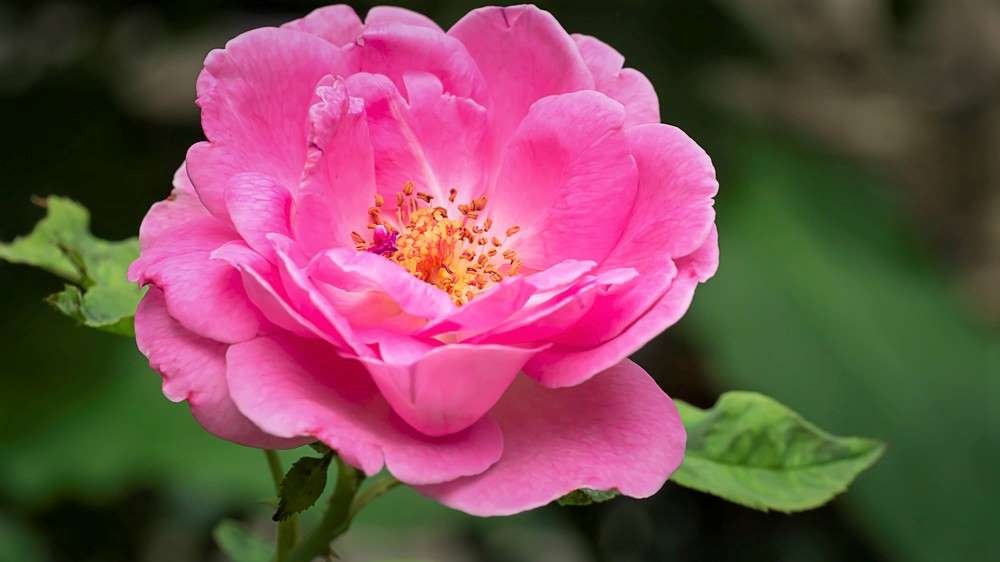Maui Island Flower: Lokelani (Damask Rose) Uses & Medicine
Lokelani, Damask Rose, or Damascene Rose, is a deciduous shrub that grows up to 2.2 meters tall, with its stems densely armed with curved prickles and stiff bristles. The pinnate leaves of the Damask rose to have five (or rarely seven) leaflets and range in color from light to moderate pink to light red. Varieties include Summer Damasks and Autumn Damasks, with ‘Celsiana’ being a flowering semi-double.
Scientists believe that the plant originated in the foothills of central Asia or Iran, a hybrid of Rosa moschata (musk rose) and Rosa gallica (French Rose, Gallic Rose, or Rose of Provins), crossed with the pollen of Rosa fedtschenkoana. The French Crusader, Robert de Brie, is sometimes credited for bringing the Damask rose from Syria to Europe, and King Henry VIII was gifted one in 1540.
Today, these roses are commercially harvested for rose oil, rose water, rose concrete, edible flower petals, herbal tea, and as gulkand (a sweet preserve). It is also the official flower of the Island of Maui.
Damask Rose Cultivation
The Damask rose is best cultivated in hedgerows to protect the blooms and facilitate harvesting. Gathering the flowers is labor-intensive, taking place 20-40 days per year, depending on the cultivar. These roses are grown in Bulgaria, Iran, Turkey, France, India, Morocco, Tunisia, and some Middle Eastern nations, with the ones cultivated in the vicinity of Kazanlak and Karlovo known as Bulgarian Roses. Turkish roses are sold as “Rose Oil,” “Turkish Rose Otto,” and “Rosa Damascena Attar,” with families still operating their small distilleries. India is also a significant producer of rose oil, “Rose Attar” and “Rose Absolutes,” as well as “Rose Concrete.”
Lokelani Culinary Uses
The Lokelani damask rose is used in cooking as a flavoring ingredient or spice, with rose water and powdered roses being popular in Middle Eastern and Indian cuisine. There is also a popular dish in the Middle East called chicken with rose and herbal tea zuhurat. Rose flavorings are used in desserts like jam, ice cream, Turkish delights, rice pudding, and yogurt. Throughout history, roses have symbolized beauty and love, and the fragrance of roses has been preserved in rose water since ancient times in the Middle East and Indian subcontinent. Rose flavoring has seen a revival in 21st-century television cooking (Source: Wikipedia.org).
Damask Rose Pharmacological Effects
Damask Rose is a species that dates back 30 million years, originating in the Middle East. It’s a bushy shrub that stands 1-2 meters tall and boasts large, colorful flowers. It can live up to 50 years and has been used for medicinal purposes for centuries. Traditionally, it has been used to treat abdominal and chest pain, strengthen the heart, regulate menstrual bleeding, ease coughs, reduce inflammation, combat depression, grief, and stress, and promote wound healing and skin health. It has also been used to treat allergies and headaches.
Rose water, Rose oil, dried flowers, Hydrosol, Absolute, Ethanolic, Aqueous, and Chloroformic Extractions are all derived from Damask roses. In Iran, both dried and fresh hips are processed for use.
Damask Rose contains over 95 macro- and micro-components and has a variety of chemical components such as terpenes, glycosides, flavonoids, anthocyanins, carboxylic acid, myrcene, vitamin C, kaempferol, quercetin, fatty oil, organic acids, nonadecane, geraniol, nerol ad more.
The pharmacological functions of Damask Rose range from antioxidants to free-radical scavengers, anticancer agents, anti-inflammatories, antimutagenics, antidepressants, hypnotics, anticonvulsants, anti-anxiety agents, and analgesics.
It has been found to increase sleeping time in mice, likely due to flavonoids and terpenes that act on central benzodiazepine receptors and the GABAergic system.
The ethanolic extract has also been found to have a potent analgesic effect in acetic acid and formalin tests, likely due to the quercetin, kaempferol, and flavonoids present.
Damask Rose protects against neuritic atrophy and has beneficial effects on the brain, including the treatment of dementia. It also has beneficial antiepileptic effects, reduces the number of coughs, has anti-tussive and bronchodilatory effects, and relaxes the tracheal smooth muscle of guinea pigs.
Additionally, it increases heart rate and contractility in isolated guinea pig hearts, suppresses angiotensin I-converting enzyme (ACE) activity, and reduces postprandial glucose levels.
Damask Rose has antimicrobial activity against Escherichia coli and other bacteria, as well as an antioxidant property due to phenolic compounds found in its parts. It has anti-inflammatory effects due to vitamin C and a laxative effect when given as a boiled extract to rats.
It is also part of a polyherbal formulation that protects against surgically induced reflux esophagitis, extends Drosophila life span due to its antioxidant properties, and has an anti-lipase effect. On top of this, herbal eye drops containing Damask Rose are helpful in various ophthalmic disorders (Source: Pharmacological Effects of Rosa Damascena).

